Spatio-Temporal Pattern Estimation of PM2.5 in Beijing-Tianjin-Hebei Region Based on MODIS AOD and Meteorological Data Using the Back Propagation Neural Network
Abstract
:1. Introduction
2. Materials and Methods
2.1. Study Area
2.2. Data
2.2.1. Ground PM2.5 Measurements
2.2.2. Meteorological Data
2.2.3. Satellite AOD Dataset
2.3. Methodology
2.3.1. Data Pre-Processing
2.3.2. ANN Model
2.3.3. Model Evaluation
3. Results and Discussion
3.1. Descriptive Statistics
3.2. Model Validation
3.3. Estimation of PM2.5 Concentration
4. Conclusions
- Sometimes there are gaps in the area covered by the satellites; the higher temporal resolution will reduce the gaps in AOD data. Satellite remote sensing data from Terra MODIS AOD, Landsat 8, the Visible Infrared Imaging Radiometer Suite (VIIRS) onboard Suomi National Polar-Orbiting Partnership (Suomi NPP), and Environment and Disaster Monitoring Small Satellite (HJ-1) may provide better AOD data [46,47].
- Light detection and ranging (Lidar) data will be considered in the future to estimate the aerosol vertical profile and components, which would be helpful in understanding the vertical distribution and source of PM2.5 concentration [48]. In addition, the interpolation of meteorological data should also be studied to obtain the most accurate spatial distribution data, which can improve the estimation precision of the PM2.5 concentration distribution.
Acknowledgments
Author Contributions
Conflicts of Interest
References
- Pope, C.A., III; Burnett, R.T.; Thun, M.J.; Calle, E.E.; Krewski, D.; Ito, K.; Thurston, G.D. Lung cancer, cardio pulmonary mortality, and long-term exposure to fine particulate air pollution. JAMA 2002, 287, 1132–1141. [Google Scholar] [CrossRef] [PubMed]
- Lepeule, J.; Laden, F.; Dockery, D.; Schwartz, J. Chronic exposure to fine particles and mortality: An extended follow-up of the Harvard six cities study from 1974 to 2009. Environ. Health Perspect. 2012, 120, 965–970. [Google Scholar] [CrossRef] [PubMed] [Green Version]
- WanMahiyuddin, W.R.; Sahani, M.; Aripin, R.; Latif, M.T.; Thach, T.Q.; Wong, C.M. Short-term effects of daily air pollution on mortality. Atmos. Environ. 2013, 65, 69–79. [Google Scholar] [CrossRef]
- Dominici, F.; Peng, R.D.; Bell, M.L.; Pham, L.; McDermott, A.; Zeger, S.L.; Samet, J.M. Fine particulate air pollution and hospital admission for cardiovascular and respiratory diseases. J. Am. Med. Assoc. 2006, 295, 1127–1134. [Google Scholar] [CrossRef] [PubMed]
- Yang, F.M.; Ma, Y.L.; He, K.B. A brief introduction to PM2.5 and related research. World Environ. 2000, 2000, 32–34. [Google Scholar]
- Kaufman, Y.J.; Tanré, D.; Boucher, O. A satellite view of aerosols in the climate system. Nature 2002, 419, 215–223. [Google Scholar] [CrossRef] [PubMed]
- Cao, J.J.; Shen, Z.X.; Chow, J.C.; Watson, J.G.; Lee, S.C.; Tie, X.X.; Ho, K.F.; Wang, G.H.; Han, Y.M. Winter and summer PM2.5 chemical compositions in fourteen Chinese cities. J. Air Waste Manag. Assoc. 2012, 62, 1214–1226. [Google Scholar] [CrossRef] [PubMed]
- Engel-Cox, J.A.; Hoff, R.M.; Haymet, A.D.J. Recommendations on the use of satellite remote-sensing data for urban air quality. J. Air Waste Manag. Assoc. 2004, 54, 1360–1371. [Google Scholar] [CrossRef] [PubMed]
- Koelemeijer, R.B.A.; Homan, C.D.; Matthijsen, J. Comparison of spatial and temporal variations of aerosol optical thickness and particulate matter in Europe. Atmos. Environ. 2006, 40, 5304–5315. [Google Scholar] [CrossRef]
- Yap, X.Q.; Hashim, M. A robust calibration approach for PM10 prediction from MODIS aerosol optical depth. Atmos. Chem. Phys. Discuss. 2012, 12, 31483–31505. [Google Scholar] [CrossRef]
- Engel-Cox, J.A.; Holloman, C.H.; Coutant, B.W.; Hoff, R.M. Qualitative and quantitative evaluation of MODIS satellite sensor data for regional and urban scale air quality. Atmos. Environ. 2004, 38, 2495–2509. [Google Scholar] [CrossRef]
- Engel-Cox, J.A.; Young, G.S.; Hoff, R.M. Application of satellite remote-sensing data for source analysis of fine particulate matter transport events. J. Air Waste Manag. Assoc. 2005, 55, 1389–1397. [Google Scholar] [CrossRef] [PubMed]
- Wang, J.; Christopher, S.A. Inter-comparison between satellite-derived aerosol optical thickness and PM2.5 mass: Implications for air quality studies. Geophys. Res. Lett. 2003, 30. [Google Scholar] [CrossRef]
- Chu, D.A.; Kaufman, Y.J.; Zibordi, G.; Chern, J.D.; Mao, J.; Li, C.; Holben, B.N. Global monitoring of air pollution over land from the Earth Observing System-Terra Moderate Resolution Imaging Spectroradiometer (MODIS). J. Geophys. Res. 2003, 108. [Google Scholar] [CrossRef]
- Liu, Y.; Jeremy, A.S.; Vasu, K.; Daniel, J.J.; Petros, K. Estimating ground-level PM2.5 in the eastern United States using satellite remote sensing. Environ. Sci. Technol. 2005, 39, 3269–3278. [Google Scholar] [CrossRef] [PubMed] [Green Version]
- Gupta, P.; Christopher, S.A. Particulate matter air quality assessment using integrated surface, satellite, and meteorological products: 2. A neural network approach. J. Geophys. Res. 2009, 114. [Google Scholar] [CrossRef]
- Liu, Y.; Paciorek, C.J.; Koutrakis, P. Estimating regional spatial and temporal variability of PM2.5 concentrations using satellite data, meteorology, and land use information. Environ. Health Perspect. 2009, 117, 886–892. [Google Scholar] [CrossRef] [PubMed] [Green Version]
- Hu, X.F.; Waller, L.A.; Lyapustin, A.; Wang, Y.J.; Al-Hamdan, M.Z.; Crosson, W.L.; Estes, M.G.; Estes, S.M.; Quattrochi, D.A.; Puttaswamy, S.J.; et al. Estimating ground-level PM2.5 concentrations in the Southeastern United States using MAIAC AOD retrievals and a two-stage model. Remote Sens. Environ. 2014, 140, 220–232. [Google Scholar] [CrossRef]
- Lin, C.; Li, Y.; Yuan, Z.; Lau, A.K.H.; Li, C.; Fung, J.C.H. Using satellite remote sensing data to estimate the high-resolution distribution of ground-level PM2.5. Remote Sens. Environ. 2015, 156, 117–128. [Google Scholar] [CrossRef]
- You, W.; Zang, Z.; Zhang, L.; Li, Z.; Chen, D.; Zhang, G. Estimating ground-level PM10 concentration in northwestern China using geographically weighted regression based on satellite AOD combined with CALIPSO and MODIS fire count. Remote Sens. Environ. 2015, 168, 276–285. [Google Scholar] [CrossRef]
- You, W.; Zang, Z.; Pan, X.; Zhang, L.; Chen, D. Estimating PM2.5 in Xi’an, China using aerosol optical depth: A comparison between the MODIS and MISR retrieval models. Sci. Total Environ. 2015, 505, 1156–1165. [Google Scholar] [CrossRef] [PubMed]
- Ma, Z.; Hu, X.; Huang, L.; Bi, J.; Liu, Y. Estimating Ground-Level PM2.5 in China Using Satellite Remote Sensing. Environ. Sci. Technol. 2014, 48, 7436–7444. [Google Scholar] [CrossRef] [PubMed]
- Song, W.; Jia, H.; Huang, J.; Zhang, Y. A satellite-based geographically weighted regression model for Regional PM2.5 estimation over the Pearl River Delta region in China. Remote Sens. Environ. 2014, 154, 1–7. [Google Scholar] [CrossRef]
- Remer, L.A.; Mattoo, S.; Levy, R.C.; Munchak, L. MODIS 3 km aerosol product: Algorithm and global perspective. Atmos. Meas. Tech. 2013, 6, 1829–1844. [Google Scholar] [CrossRef]
- National Bureau of Statistics of China (NBSC). China Statistical Year Book; China Statistics Press: Beijing, China, 2015. (In Chinese) [Google Scholar]
- Xing, Y.; Song, H.; Yu, M.; Wang, C.; Zhou, Y.; Liu, G.; Du, L. The Characteristics of Greenhouse Gas Emissions from Heavy-Duty Trucks in the Beijing-Tianjin-Hebei (BTH) Region in China. Atmosphere 2016, 7, 121. [Google Scholar] [CrossRef]
- Li, Y.; Wang, J.; Chen, C.; Chen, Y.; Li, J. Estimating PM2.5 in the Beijing-Tianjin-Hebei Region Using MODIS AOD Products from 2014 to 2015. In Proceedings of the XXIII International Society for Photogrammetry and Remote Sensing Congress, Prague, Czech Republic, 12–19 July 2016; Volume XLI-B2, pp. 721–727. [Google Scholar] [CrossRef]
- The National Urban Air Quality Real-Time Publishing Platform. Available online: http://113.108.142.147:20035/emcpublish/ (accessed on 20 July 2017).
- Global Climate Data. Available online: https://en.tutiempo.net/climate/ (accessed on 20 July 2017).
- Olea, R.A. Geostatistics for Engineers and Earth Scientists; Springer: New York, NY, USA, 1999. [Google Scholar]
- Ni, X.; Park, T.; Choi, S.; Shi, Y.; Cao, C.; Wang, X.; Lefsky, M.A.; Simard, M.; Myneni, R.B. Allometric scaling and resource limitations model of tree heights: Part 3. Model optimization and testing over continental China. Remote Sens. 2014, 6, 3533–3553. [Google Scholar] [CrossRef]
- Ni, X.; Zhou, Y.; Cao, C.; Wang, X.; Shi, Y.; Park, T.; Choi, S.; Myneni, R.B. Mapping Forest Canopy Height over Continental China Using Multi-Source Remote Sensing Data. Remote Sens. 2015, 7, 8436–8452. [Google Scholar] [CrossRef]
- Leigh, M.; Robert, L.; Shana, M.; Lorraine, R. MODIS Atmosphere Team Webinar Series #5: Overview of the 3 km Aerosol Product in Collection 6. 2014. Available online: https://modis-images.gsfc.nasa.gov/Webinar2014/MODISAtmWebinar3SayerDB.pdf (accessed on 20 July 2017).
- Levy, R.C.; Mattoo, S.; Munchak, L.; Remer, L.A.; Sayer, A.M.; Hsu, N.C. The collection 6 MODIS aerosol products over land and ocean. Atmos. Meas. Tech. 2013, 11, 2989–3034. [Google Scholar] [CrossRef]
- Hsu, N.; Jeong, M.J.; Bettenhausen, C.; Sayer, A.; Hansell, R.; Seftor, C.S.; Huang, J.; Tsay, S.-C. Enhanced Deep Blue aerosol retrieval algorithm: The second generation. J. Geophys. Res. Atmos. 2013, 118, 9296–9315. [Google Scholar] [CrossRef]
- The MODIS Level 2 Aerosol Products (Collection 6) Referrer to the LAADS Website. Available online: http://ladsweb.nascom.nasa.gov/data/search.html (accessed on 20 July 2017).
- Ma, Z.W.; Hu, X.F.; Sayer, A.M.; Levy, R.; Zhang, Q.; Xue, Y.G.; Bi, J.; Lei, H.; Liu, Y. Satellite-based spatiotemporal trends in PM2.5 concentrations: China, 2004–2013. Environ. Health Perspect. 2015, 124, 184. [Google Scholar] [CrossRef] [PubMed]
- McCulloch, W.S.; Pitts, W.H. A logical calculus of the ideas immanent in neural nets. Bull. Math. Biophys. 1943, 5, 115–133. [Google Scholar] [CrossRef]
- Samardak, A.; Nogaret, A.; Janson, N.B.; Balanov, A.G.; Farrer, I.; Ritchie, D.A. Noise-Controlled Signal Transmission in a Multithread Semiconductor Neuron. Phys. Rev. Lett. 2009, 102, 226802. [Google Scholar] [CrossRef] [PubMed]
- Maier, H.R.; Dandy, G.C. Neural networks for the prediction and forecasting of water resources variables: A review of modelling issues and applications. Environ. Model. Softw. 2000, 15, 101–124. [Google Scholar] [CrossRef]
- Wang, L.X.; Mendel, J.M. Back-propagation fuzzy systems as nonlinear dynamic system identifiers. In Proceedings of the IEEE 1992 International Conference on Fuzzy Systems, San Diego, CA, USA, 8–12 March 1992; pp. 1409–1418. [Google Scholar]
- Rodriguez, J.D.; Perez, A.; Lozano, J.A. Sensitivity analysis of k-fold cross validation in prediction error estimation. IEEE Trans. Pattern Anal. Mach. Intell. 2010, 32, 569–575. [Google Scholar] [CrossRef] [PubMed]
- Emili, E.; Popp, C.; Petitta, M.; Riffler, M.; Wunderle, S.; Zebisch, M. PM10 remote sensing from geostationary SEVIRI and polar-orbiting MODIS sensors over the complex terrain of the European Alpine region. Remote Sens. Environ. 2010, 114, 2485–2499. [Google Scholar] [CrossRef]
- Wang, J.; Li, X.; Zhang, W.; Jiang, N.; Zhang, R.; Tang, X. Secondary PM2.5 in Zhengzhou, China: Chemical Species Based on Three Years of Observations. Aerosol Air Qual. Res. 2016, 16, 91–104. [Google Scholar] [CrossRef]
- Chen, Y.; Han, W.; Chen, S.; Tong, L. Estimating ground-level PM2.5 concentration using Landsat 8 in Chengdu, China. In Proceedings of the SPIE Asia-Pacific Remote Sensing, Beijing, China, 13–16 October 2014; Volume 9259, p. 925917. [Google Scholar] [CrossRef]
- Zhao, X.; Shi, H.; Yu, H.; Yang, P. Inversion of Nighttime PM2.5 Mass Concentration in Beijing Based on the VIIRS Day-Night Band. Atmosphere 2016, 7, 136. [Google Scholar] [CrossRef]
- Zhengqiang, L.; Yuhuan, Z.; Ying, Z.; Weizhen, H.; Yan, M.; Cheng, C. Remote sensing of atmospheric PM2.5 from high spatial resolution image of Chinese environmental satellite HJ-1/CCD data. In IOP Conference Series: Earth and Environmental Science; IOP Publishing: Bristol, UK, 2014; Volume 17, p. 012023. [Google Scholar] [CrossRef]
- Xiang, Y.; Zhang, T.; Zhao, X.S.; Liu, J.; Dong, Y.S.; Fan, G.; Liu, Y. Retrieval of PM2.5 Concentration from Lidar Data. In Light, Energy and the Environment 2015; OSA Technical Digest; Paper EM3A.6; Optical Society of America: Washington, DC, USA, 2015. [Google Scholar]
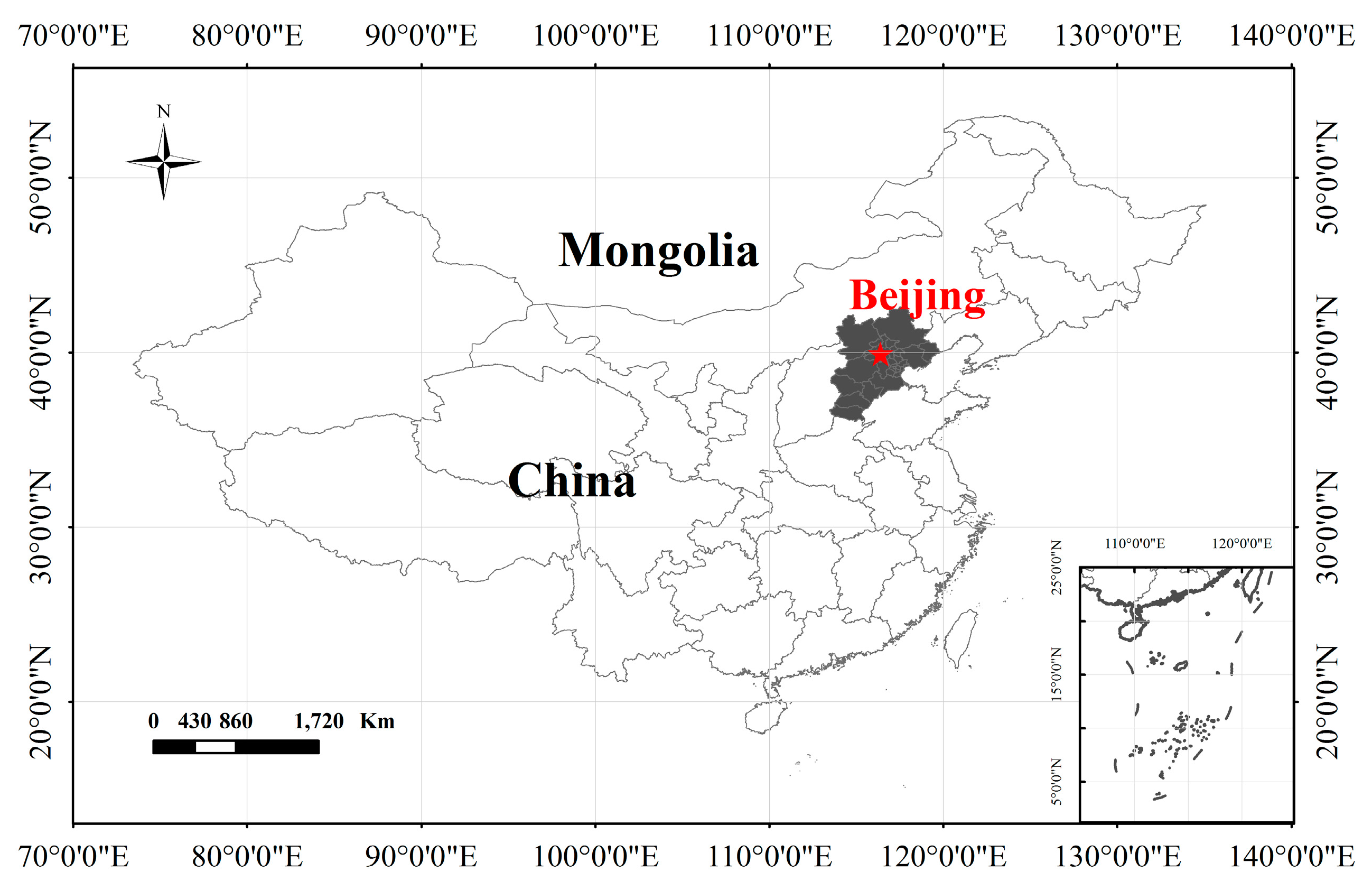


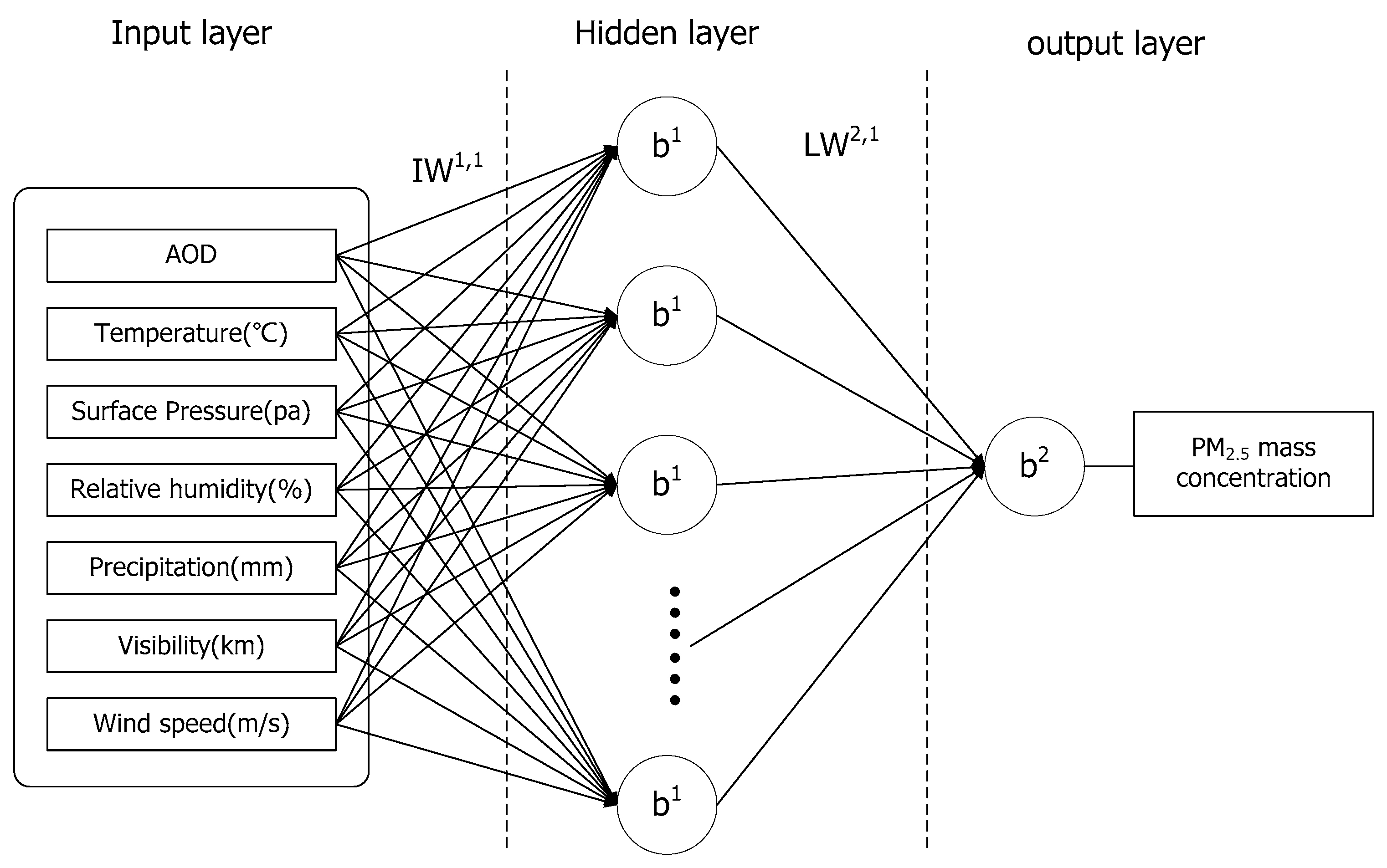
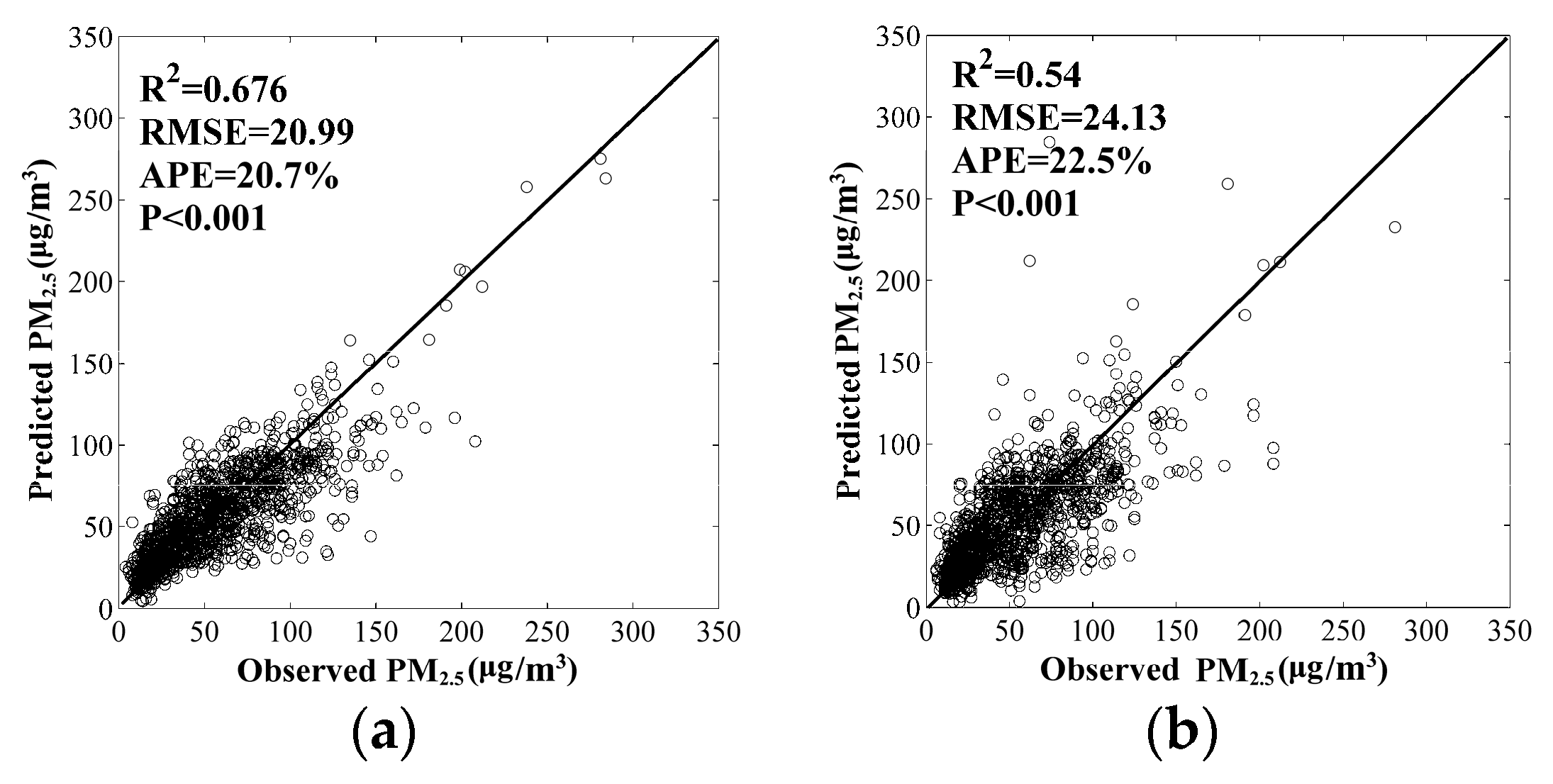

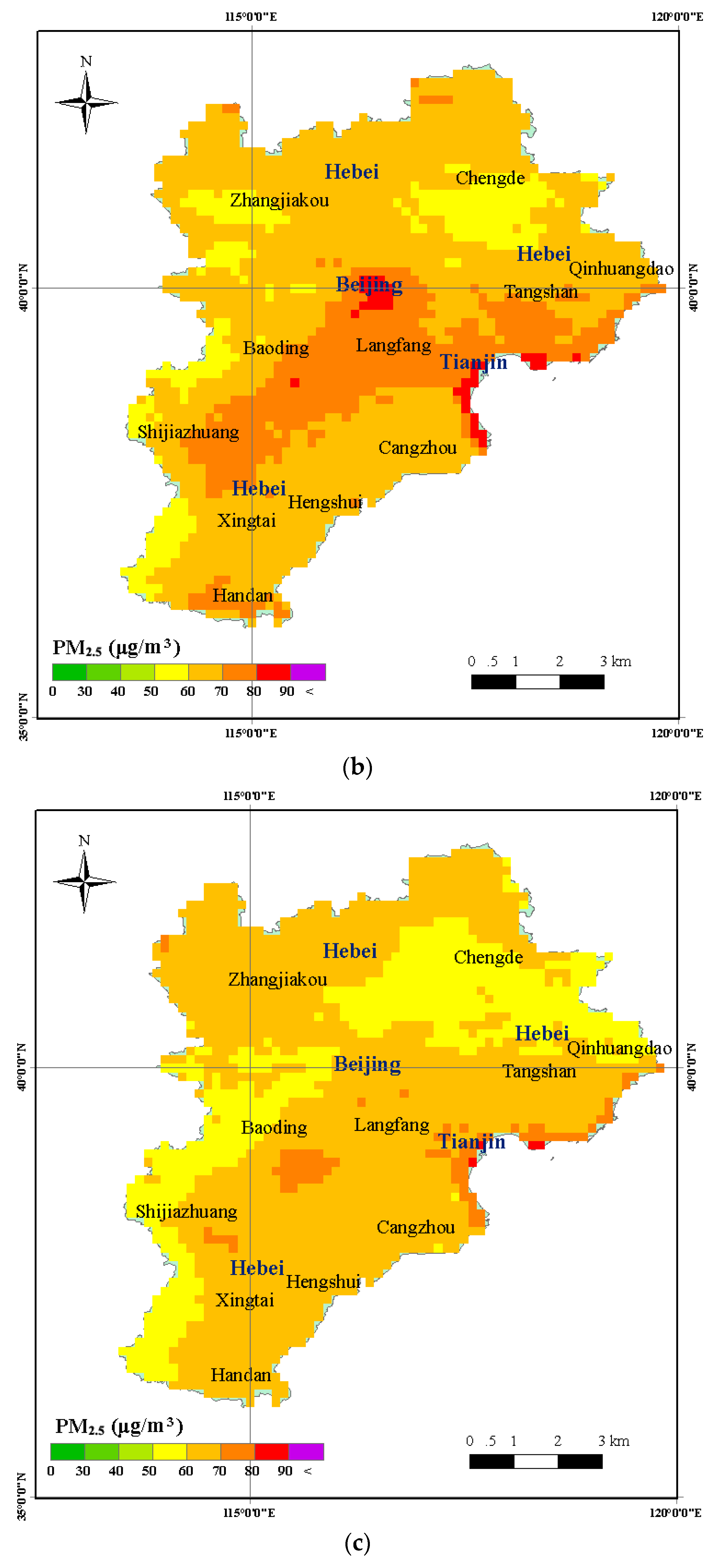
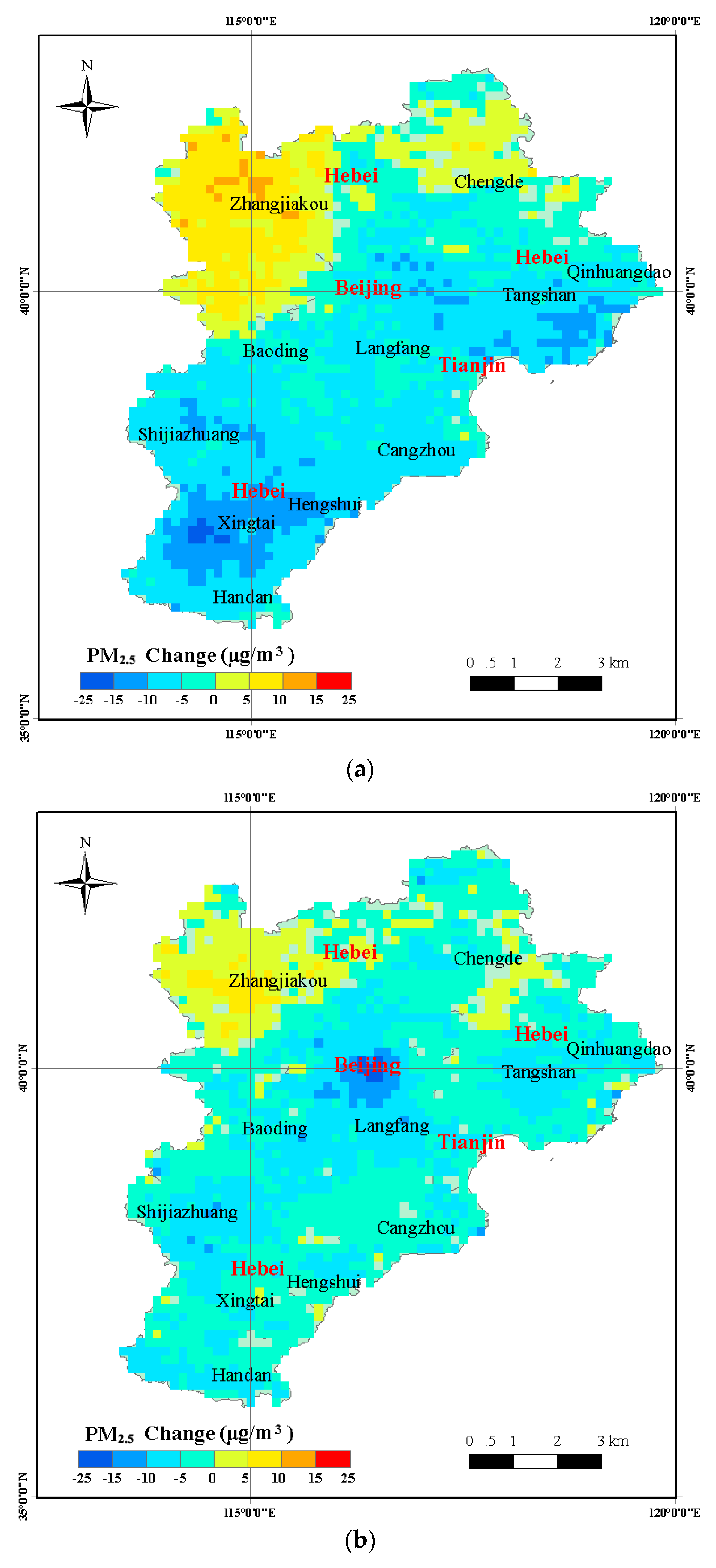
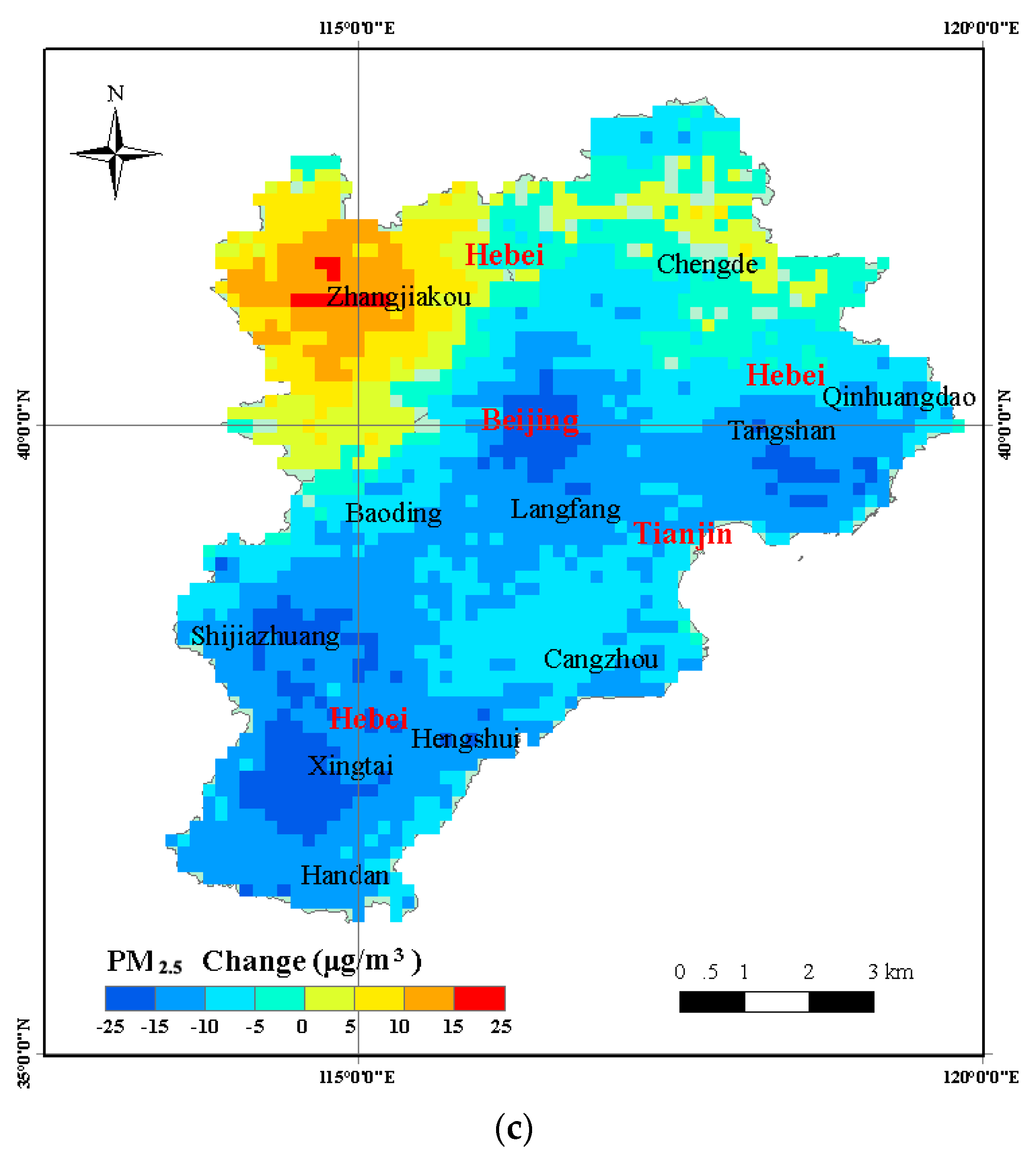
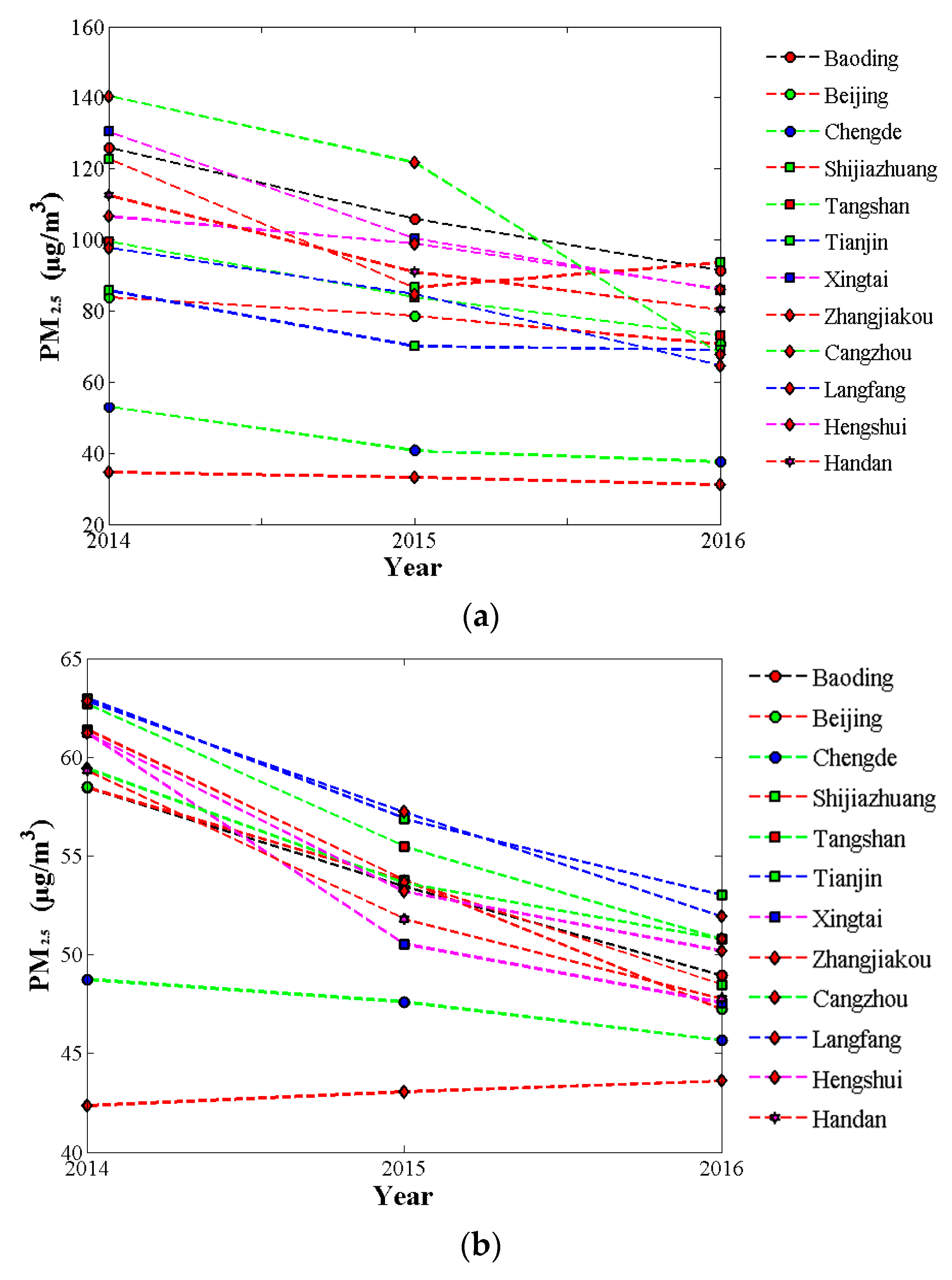
| Data Type | Data | Acquired Time | Spatial Resolution | Source |
|---|---|---|---|---|
| Ground-level PM2.5 | PM2.5 () | 2014.1–2016.12 | N/A | Tianqihoubao |
| Satellite Data | Aqua MODIS AOD products | 2014.1–2016.12 | 3 km × 3 km | National Aeronautics and Space Administration (NASA), MODIS Team |
| Meteorological Data | Temperature (°C) | 2014.1–2016.12 | Global climate data | |
| Surface Pressure (pa) | ||||
| Relative humidity (%) | ||||
| Precipitation (mm) | ||||
| Visibility (km) | ||||
| Wind speed (m/s) |
| Parameters | Mean | SD | Min | Max |
|---|---|---|---|---|
| PM2.5 () | 81.33 | 53.19 | 3.00 | 739.00 |
| MODIS AOD | 0.64 | 0.60 | 0.03 | 4.49 |
| Temperature (°C) | 17.94 | 11.50 | −10.10 | 38.10 |
| Surface Pressure (pa) | 1017.25 | 10.71 | 994.60 | 1054.40 |
| Relative Humidity (%) | 55.04 | 20.35 | 10.00 | 100.00 |
| Precipitation (mm) | 2.52 | 11.86 | 0.00 | 311.60 |
| Visibility (km) | 15.24 | 8.78 | 0.30 | 29.90 |
| Wind Speed (m/s) | 9.53 | 4.03 | 1.50 | 39.60 |
© 2018 by the authors. Licensee MDPI, Basel, Switzerland. This article is an open access article distributed under the terms and conditions of the Creative Commons Attribution (CC BY) license (http://creativecommons.org/licenses/by/4.0/).
Share and Cite
Ni, X.; Cao, C.; Zhou, Y.; Cui, X.; P. Singh, R. Spatio-Temporal Pattern Estimation of PM2.5 in Beijing-Tianjin-Hebei Region Based on MODIS AOD and Meteorological Data Using the Back Propagation Neural Network. Atmosphere 2018, 9, 105. https://doi.org/10.3390/atmos9030105
Ni X, Cao C, Zhou Y, Cui X, P. Singh R. Spatio-Temporal Pattern Estimation of PM2.5 in Beijing-Tianjin-Hebei Region Based on MODIS AOD and Meteorological Data Using the Back Propagation Neural Network. Atmosphere. 2018; 9(3):105. https://doi.org/10.3390/atmos9030105
Chicago/Turabian StyleNi, Xiliang, Chunxiang Cao, Yuke Zhou, Xianghui Cui, and Ramesh P. Singh. 2018. "Spatio-Temporal Pattern Estimation of PM2.5 in Beijing-Tianjin-Hebei Region Based on MODIS AOD and Meteorological Data Using the Back Propagation Neural Network" Atmosphere 9, no. 3: 105. https://doi.org/10.3390/atmos9030105







